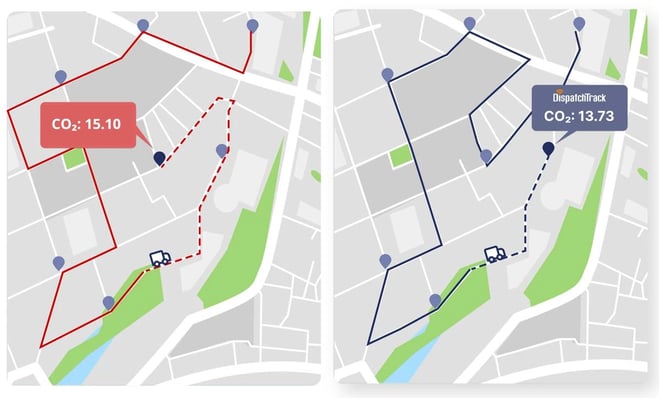You may also like
Subscribe now
for a weekly blog digest containing growth tips, industry updates, and product announcements!
6 Minute Read
When logistics professionals think about obstacles to going green in the last mile, a number of hurdles probably come to mind: accurately measuring CO2 output, finding electric vehicles, etc. But what about cost?

We’d be willing to bet that many businesses, faced with the desire to make their operations more sustainable, are slowed down by thinking that reducing their CO2 output is going to be too expensive to be feasible—especially in markets where margins are razor-thin and volatile demand makes any big changes risky.
It’s an understandable reaction—but it’s also a serious misconception. While many of the investments required to reduce your carbon footprint will be just that—investments—many of the tactics that you can adopt right now to try and immediately impact your sustainable initiatives can actually go hand in hand with saving money.
How is this possible? The simple answer is that powering more efficient operations overall is also one of the keys to becoming more carbon-efficient in particular. In other words, when everything goes right in the last mile, it’s actually better for the planet.
Before we dig into how, exactly, it’s possible to leverage sustainability initiatives in a way that actually dovetails with improved cost efficiency, let’s look at exactly what we mean by “everything going right” when it comes to last mile logistics. When people say that last mile deliveries are fundamentally inefficient, part of what they mean is that it’s difficult to craft delivery routes that minimize the amount of travel time and distance to hit all the relevant stops.
This is undoubtedly true, and it has historically resulted in more miles being driven than necessary—and thus more fuel being consumed than necessary. But the other piece of the puzzle is this: when the last mile is a black box with limited visibility after your trucks leave the warehouse, it’s virtually impossible to ensure that everything is actually going according to plan. Drivers could be arriving late for important deliveries, customers might not be home when the drivers do arrive, items could be returned because they’re damaged or simply the wrong color—you simply don’t know until your drivers come back to the DC at the end of the day. By that point, there’s not much to do but try and clean up the mess with the plans for the next day.
To counteract this fundamental inefficiency, last mile delivery organizations need to affect a digital transformation in the way they plan, manage, and track their order fulfillment processes. This might include a few elements at minimum:
Of course, when it comes to boosting efficiency in the last mile, this is just the tip of the iceberg. Optimizing return management and reverse logistics is a big piece of the puzzle. So are inventory management considerations that arise from last mile performance (e.g. leveraging smoother last mile operations into inventory shrink). Broadly speaking, digital transformation should be able to help you address all of these areas from a holistic perspective and ultimately create a smoother, more flexible, and more cost-efficient delivery process.
Nothing that we’ve been describing above should look like a luxury. With costs for labor and goods rising and the driver shortage continuing, efficiency in the planning and execution of deliveries is non-negotiable. And by investing in technology that can boost efficiency, you set yourself up to get more out of your delivery capacity and minimize the number of costly failed deliveries—all while saving time and money on back-office processes as well.
In those terms, investing in efficiency gains seems like a no-brainer. So why, when it comes to going green, does the same logic not seem to apply?
After all, the exact same sorts of efficiency gains that we’ve been discussing are the sorts of things that can go a long way towards decreasing your carbon emissions:
The long and short of this is that by prioritizing efficiency, you can actually go a long way towards furthering sustainability as well. The two concepts go hand in hand in a number of ways—meaning that the old myth that going green is an expensive process that’s not likely to yield immediate ROI is simply false.
All that being said, there are plenty of reasons that efficiency isn’t the default in last mile operations. And as businesses work towards leveraging their efficiency gains into decreased CO2 emissions, there are new sets of hurdles that have to be overcome. For instance:
As sustainability initiatives evolve, there will undoubtedly be other unforeseen challenges that crop up. That’s why one of the keys to both efficiency and sustainability is to ensure flexibility and adaptability at every stage of the process. If you can make that happen, you can power green last mile logistics programs that simultaneously boost efficiency across the board.
for a weekly blog digest containing growth tips, industry updates, and product announcements!